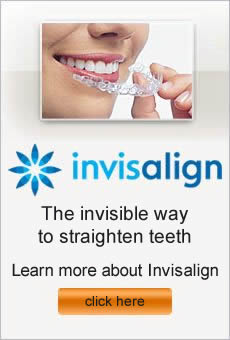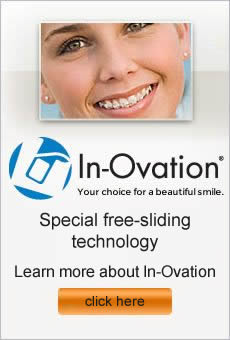Are you an adult who is unhappy with your smile, but don’t want to walk around with “metal-mouth” looking like a teenager? Thanks to advances in orthodontic treatments, Invisalign can offer you a convenient, appealing, and efficient option to straightening your teeth and achieving the beautiful smile of your dreams.
Invisalign utilizes a set of clear trays, or aligners, to gently and quickly move your teeth into the desired position. With Invisalign, your daily routine will undergo very few changes. Because the trays are removable, you will take them out to brush and floss normally. The aligners are easy to clean with a brush and warm water. This makes your morning and nighttime routine nearly the same as before treatment with Invisalign.
Because you remove the aligners when eating, there is no worry with Invisalign about the foods you eat damaging your orthodontia or about foods getting stuck in brackets or wires. Likewise, when playing sports there is no concern that your orthodontia will be damaged or will cut your mouth. Invisalign can be worn during contact sports, or removed if you prefer to wear a protective mouth guard while playing.
For adults, the greatest benefit of Invisalign is the aesthetic appeal. Because the aligners are clear, they are virtually unnoticeable and allow you to go about your day without worrying about a metallic smile. Invisalign treatment plans are also usually shorter than treatment with traditional braces. Schedule a consultation with a qualified orthodontist to find out if you are a candidate for Invisalign and get on your way to a straighter, more beautiful smile.
Selecting an orthodontic practice to trust with the future of your family’s smiles is not a decision to take lightly. Orthodontic treatment can be an extended process, so it is crucial to ensure your family is comfortable with the orthodontist and staff. Your family dentist will likely be able to offer recommendations for orthodontists in your area. It’s also a good idea to ask for feedback from friends about their experience with area orthodontic practices.
Once you have identified and narrowed down several potential orthodontists, schedule a consultation with each office and consider the following when you visit:
What is the educational background of the orthodontist? Find out where they went to school, and what kind of specialty training and continuing education they have completed.
Are they a licensed member of the American Association of Orthodontists? This designation ensures the doctor stays current on the latest advances in orthodontic treatment.
What is the orthodontist’s level of experience and how long have they been practicing?
Is the office conveniently located to your home, work, or school? Orthodontic treatment requires regular visits to check progress and make adjustments, making location an important consideration.
Do they offer convenient hours for before and after school or work appointments?
Is the staff welcoming and helpful, and is the office warm and inviting? Again, because you will frequently be visiting, it is crucial that you or your child feel comfortable and can establish a good rapport with the doctor and support staff.
What is the orthodontist’s treatment plan for your particular case? Find out what options the doctor recommends for your orthodontic care, as well as the recommended treatment timeline. Ask about follow-up care once braces are removed.
Did the orthodontist answer your questions and pay attention to your concerns?
Getting braces means making a big commitment to one orthodontist for several years, so don’t be afraid to do your research and look around for the best fit. Finding the right orthodontist can make the entire process of getting braces easier and more enjoyable, leading to a beautiful, healthy smile!
Braces for kids in Sherman Oaks, CA
Dentists who are trained to specialize in diagnosing, preventing, and repairing structural issues with your teeth are called orthodontists. It is no small feat to become a board-certified orthodontist, with on average at least a decade’s worth of education required to achieve this goal. This specialized training and experience is one reason that seeking treatment for misaligned or crooked teeth from an orthodontist may be worth it for your smile.
Orthodontists usually have an interest in the medical field from early in life. Even in high school, many students who end up with this career take courses in anatomy, biology, chemistry, physics, and other science-related topics to learn more about it.
After high school, a college degree is a must. Orthodontists tend to major in areas heavy in science, such as biology or chemistry. During the later college years, students intending to apply to dental school must pass the Dental Acceptance Test (DAT). If accepted to dental school, students then usually face four years of classes, lab work, and supervised practice. Real life practice in clinical environments provides useful experience for dental students while still in school. Upon graduating, students earn a Doctor of Dental Medicine degree and then must pass the National Board Dental Examinations on top of that to receive a license to practice dentistry.
Orthodontics is a specialization within dentistry, so future orthodontists must additionally complete a graduate school program for specialized training. Students may gain a master’s degree or doctorate in orthodontics, oral science, or oral biology. Training involves performing orthodontic work on actual patients. Lastly, orthodontists must pass written and clinical exams through the American Board of Orthodontics.
All of this extensive education, training, and practice means that orthodontists should be experts by the end in treating all sorts of oral issues. You should feel confident that an orthodontist will be able to help you achieve your smile goals.
Sherman Oaks Orthodontist
Did you grow up getting teased about your teeth? Have you been embarrassed by your smile to the point that it affects you professionally or personally? Do you have difficulty eating certain foods because your bite is poor? There is no reason for you to wait another moment. Braces can improve the form and function of your teeth.
Historically, braces are associated with teenagers, but today, adults in increasing numbers are turning to orthodontics to correct aesthetic and malocclusion (bad bite) issues with their teeth. As teens with bad teeth age into adults, those adults are prioritizing their smiles and are turning to braces to achieve the look they’ve always desired.
Braces work effectively in adults and children. The only difference is that in young people, the ongoing and rapid bone growth experienced in the jawbone allows the braces to do their work in less time. Even though their bones are fully formed, adults can achieve the same results with braces as teens, but the course of treatment typically takes longer.
Adults are also more likely to recognize the health benefits of straighter teeth as being as important as the end-result improved aesthetics of the teeth. Straight teeth have a lower risk of general tooth decay. Bacteria, food debris and plaque can’t hide as easily from brushes and floss in an aligned mouth, reducing the odds of developing gum disease. Straighter teeth also aid in overall digestion, as an aligned bite allows food to be chewed thoroughly before swallowing.
There are several braces types available to adults:
- Traditional braces with metal or ceramic brackets. While the ceramic brackets are less obvious than the metal ones, they are more difficult to remove and can be stained over time.
- Lingual braces are worn inside the curve of the teeth and are completely invisible, but may affect speech until the tongue adjusts.
- Invisalign aligners are popular because they are removable and are almost invisible when in the mouth.
If you are considering braces and you live in the Sherman Oaks CA area, contact Dr. Fotovat today. There are many options are available to you that will have you enjoying a new smile.
Does your child need braces, but isn’t sure about being a “metal mouth” for two or more years? Did your teen come to you and beg for some other option to traditional braces? Perhaps you’ve heard about Invisalign aligners but are wondering if they’ll work for your child. Invisalign is absolutely appropriate for your teen if all of his or her baby teeth have fallen out and adult teeth have erupted.
Invisalign provides the same results as traditional metal braces, but without the metal brackets. Concerns over eating with braces are removed with the Invisalign trays, as they come out for meals, leaving your teen free to eat any food he or she desires.
Invisalign utilizes clear plastic trays that allow the process of straightening your teen’s teeth to be less obvious and less obtrusive. Beginning with x-rays and molds, your orthodontist will make a series of trays, called aligners. These trays are worn most of the day, taken out only to eat or to be cleaned. The process of straightening happens gradually and comfortably.
It is essential during this time that the trays are worn as recommended by the orthodontist. Wearing them less than the recommended amount of time will result in slower correction, and has the potential to lengthen treatment. Have your teen continue with any established good oral hygiene habits. Brushing and flossing must continue on a regular basis, brushing twice a day at minimum and flossing before bedtime.
Being a teenager is full of difficulties, and it is during this time that teens are at their most self-conscious. Adding metal braces to this transition can make everything worse for your child, leaving him or her self-conscious about eating with friends or smiling, talking or laughing in public. Your teen’s gapped, misaligned or crowded teeth can be improved significantly with Invisalign trays. Talk to Sherman Oaks Invisalign orthodontist Dr. Fotovat today to see how Invisalign can make a difference for your child.
If you have new braces, it is important to know basic guidelines for their care so that you may successfully complete your treatment plan.
Initially, you may experience soreness of the mouth and teeth for several days after getting your braces. Rinsing your mouth with cold water may help alleviate the tenderness. You can take an over-the-counter pain reliever for more severe pain. To help with lip, tongue, or cheek sensitivity caused by the initial irritation, try using dental wax provided by your orthodontist.
For the first few days after getting your braces, you will want to stick to soft foods. While you will soon be able to return to eating normally, there are some foods you should try to avoid completely:
• Ice
• Sticky or hard candies
• Gum of any kind
• Hard chips
• Hard fruits and vegetables such as apples or carrots, unless cut into small bites
• Popcorn kernels
• Meat that must be eaten directly off the bone
• Corn on the cob
• French bread, bagels, and other hard breads unless broken into small bites
Avoid chewing on fingernails, pens, or pencils as this will damage braces.
If you play contact sports, it is recommended you wear a protective mouth guard. If you are involved in an accident to your face, check your mouth and braces immediately. Contact your orthodontist immediately if your braces are damaged or teeth are loosened.
It is vitally important to brush and regularly floss so you will maintain healthy teeth and gums after orthodontic treatment. Make sure you are brushing all surfaces of the teeth and gum line, ensuring the teeth and brackets are completely free of any food or debris. When flossing, you can either use floss designed specifically for use with braces or regular floss with a floss threader.
You should consistently wear the rubber bands or other appliances as prescribed in order for your teeth and jaws to move toward their corrected positions. If you experience a poking or loose wire, broken bracket, or any other unusual discomfort, contact Sherman Oaks orthodontist Dr. Fotovat for further assistance.



